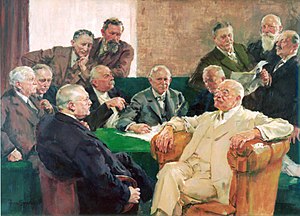
Walther Rathenau was a German industrialist, writer and politician who served as foreign minister of Germany from February to June 1922.

Wolfgang Rihm was a German composer of contemporary classical music and an academic teacher based in Karlsruhe. He was an influential post-war European composer, as "one of the most original and independent musical voices" there, composing over 500 works including several operas.

Martin Sigismund Eduard von Simson was a German jurist and distinguished liberal politician of the Kingdom of Prussia and German Empire, who served as President of the Frankfurt Parliament as well as the first President of the German Parliament and of the Imperial Court. He was ennobled by Kaiser Frederick III in 1888.

Meret Elisabeth Oppenheim was a German-born Swiss Surrealist artist and photographer.
The Verein für Socialpolitik, or the German Economic Association, is a society of economists in the German-speaking area.

Tell Halaf is an archaeological site in the Al Hasakah governorate of northeastern Syria, a few kilometers from the city of Ras al-Ayn near the Syria–Turkey border. The site, which dates to the sixth millennium BCE, was the first to be excavated from a Neolithic culture, later called the Halaf culture, characterized by glazed pottery painted with geometric and animal designs.

Anton Alexander von Werner was a German painter and illustrator, best known for his depictions of the Franco-Prussian War and the Unification of Germany, typical of the Naturalist style. Member of the Akademie der Künste from 1874, Werner was a favourite of all the three German Emperors, William I, Frederick III, and Wilhelm II.
Fabian Ludwig Georg Adolf Kurt von Schlabrendorff was a German jurist, soldier, and member of the German resistance against Adolf Hitler. From 1967 to 1975 he was a judge of the German Federal Constitutional Court.
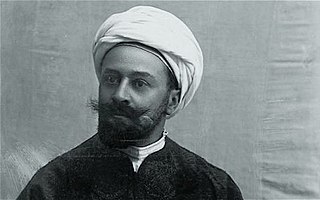
Baron Max von Oppenheim was a German lawyer, diplomat, ancient historian, pan-Islamist and archaeologist. He was a member of the Oppenheim banking dynasty. Abandoning his career in diplomacy, he discovered the site of Tell Halaf in 1899 and conducted excavations there in 1911–13 and again in 1927–29. Bringing many of his finds to Berlin, he exhibited them in a private museum in 1931. This was destroyed by Allied bombing in World War II; however, most of the findings were recently restored and have been exhibited again at Berlin and Bonn.

Walter Rudolf Leistikow (1865–1908) was a German landscape painter, graphic artist, designer and art critic.
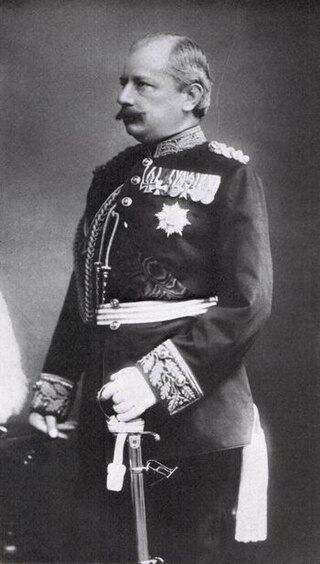
Karl August, Hereditary Grand Duke of Saxe-Weimar-Eisenach was a German prince and Hereditary Grand Duke (Erbgroßherzog) of Saxe-Weimar-Eisenach.
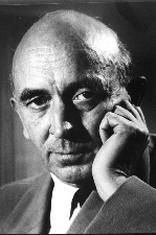
Ernst Pepping was a German composer of classical music and academic teacher. He is regarded as an important composer of Protestant sacred music in the 20th century.
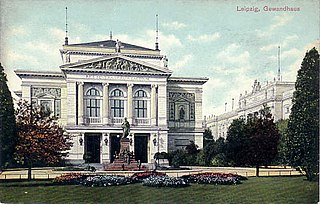
Martin Carl Philipp Gropius was a German architect.

The Mendelssohn family are the descendants of Mendel of Dessau. The German Jewish philosopher Moses Mendelssohn and his brother Saul were the first to adopt the surname Mendelssohn. The family includes his grandchildren, the composers Fanny Mendelssohn and Felix.
Ernst Werner Techow was a German right-wing assassin. In 1922, he took part in the assassination of the Foreign Minister of Germany Walther Rathenau, whose insistence that Germany follow the terms of the Treaty of the Versailles, along with his Jewish faith, enraged far-right German nationalists. After his release from prison, Techow initially joined the Nazi Party, but soon fell out with the movement and dropped into obscurity. Late in World War II, he joined the Volkssturm. Techow was killed after being captured by the Soviet Red Army near Dresden on 9 May 1945.
Hans Friedrich Wilhem Ernst von Raumer was a German politician of the German People's Party (DVP). He served as minister in two governments of the Weimar Republic and was also active as a representative of German industry.

The Wittgenstein family is a German-Austrian family that rose to prominence in 19th- and 20th-century Vienna, Austria. The family was originally Jewish and originated from the Wittgensteiner Land in Siegen-Wittgenstein, Germany.

Richard Fester was a German historian.

Ernst-Lothar von Knorr was a German composer, music educator and civil servant.

Margarete Oppenheim was a German art collector and patron. She was among the first personalities to collect works of modern art in Germany and owned one of the largest collection in Germany. She is also known as Margarete Oppenheim-Reichenheim.
